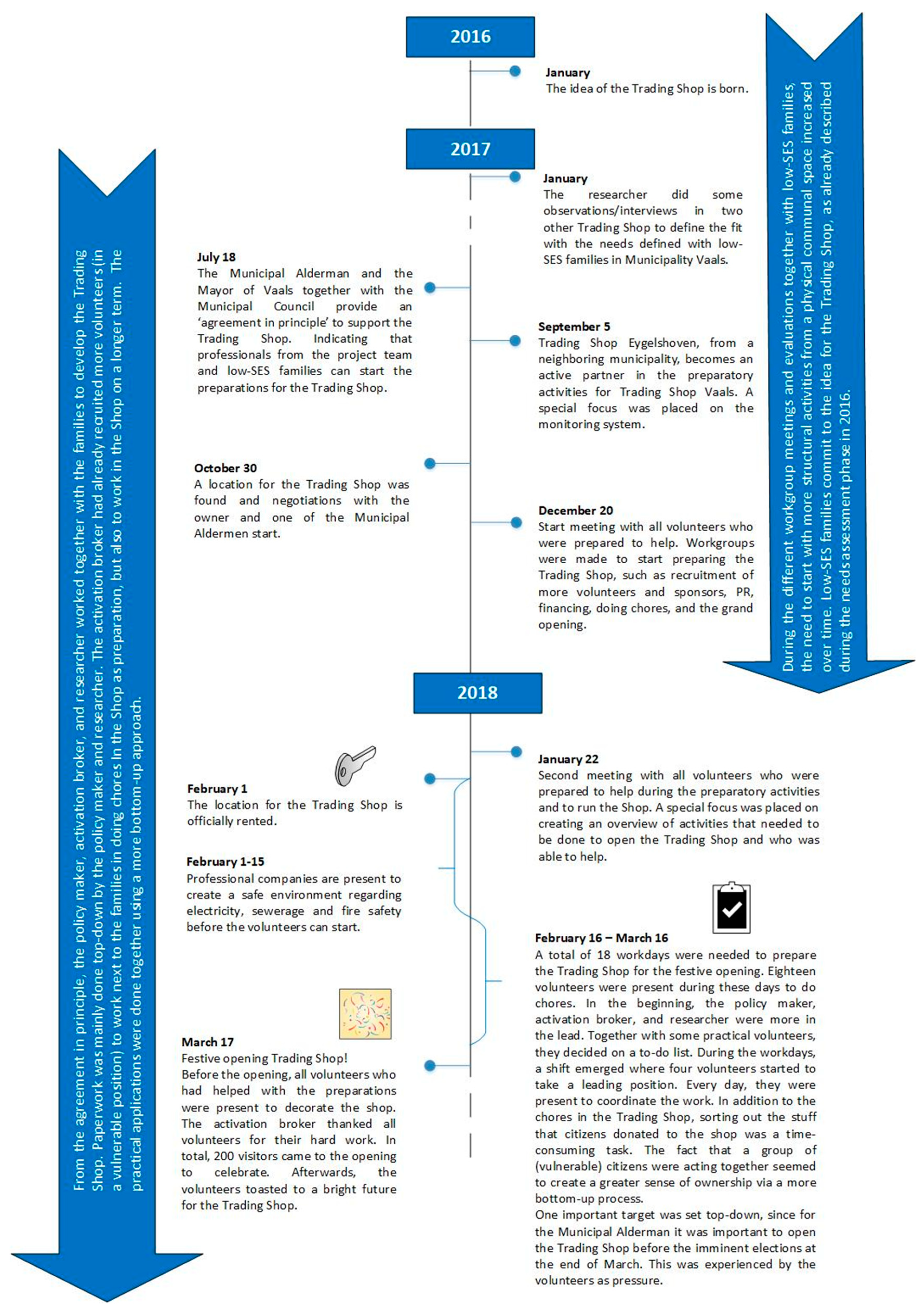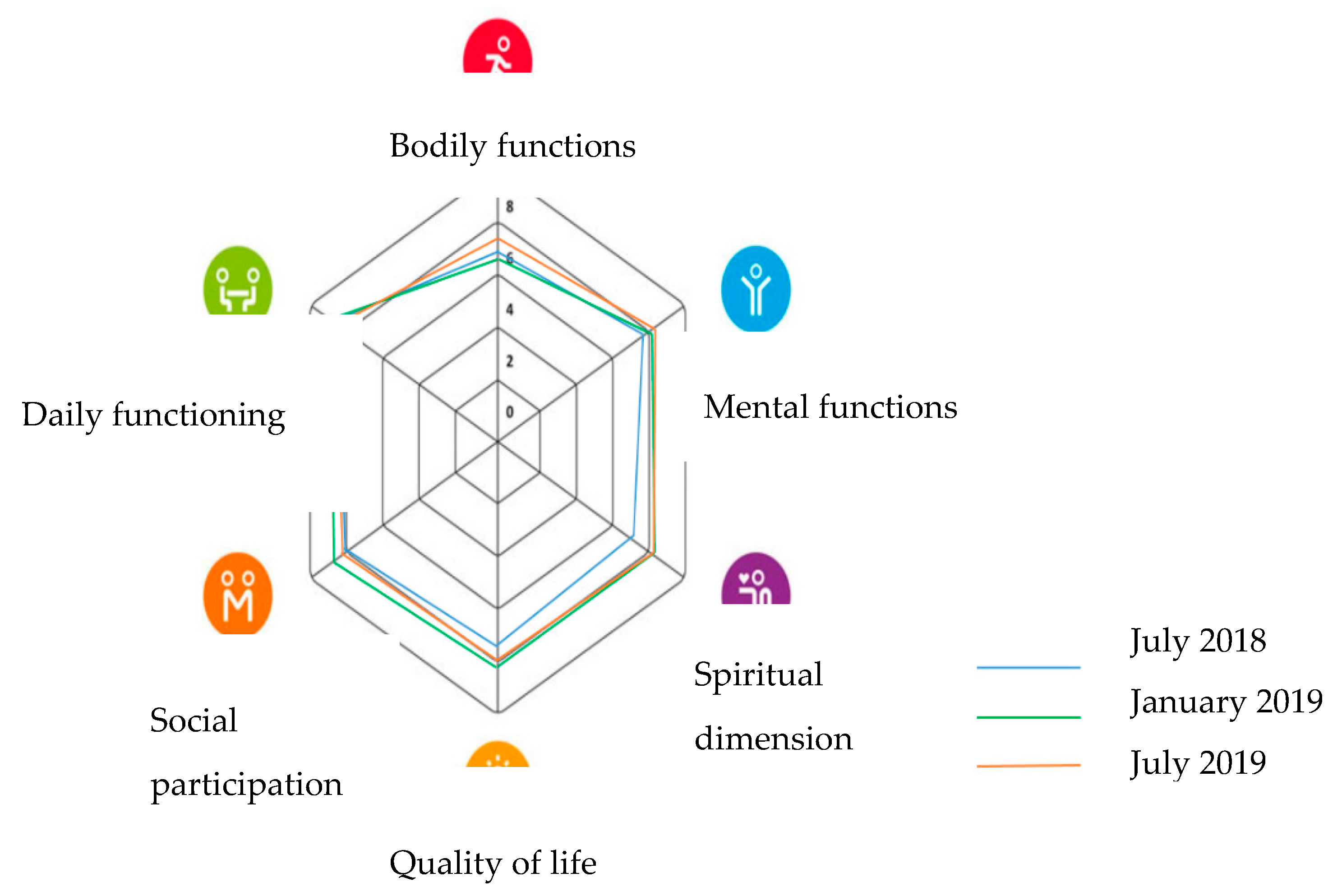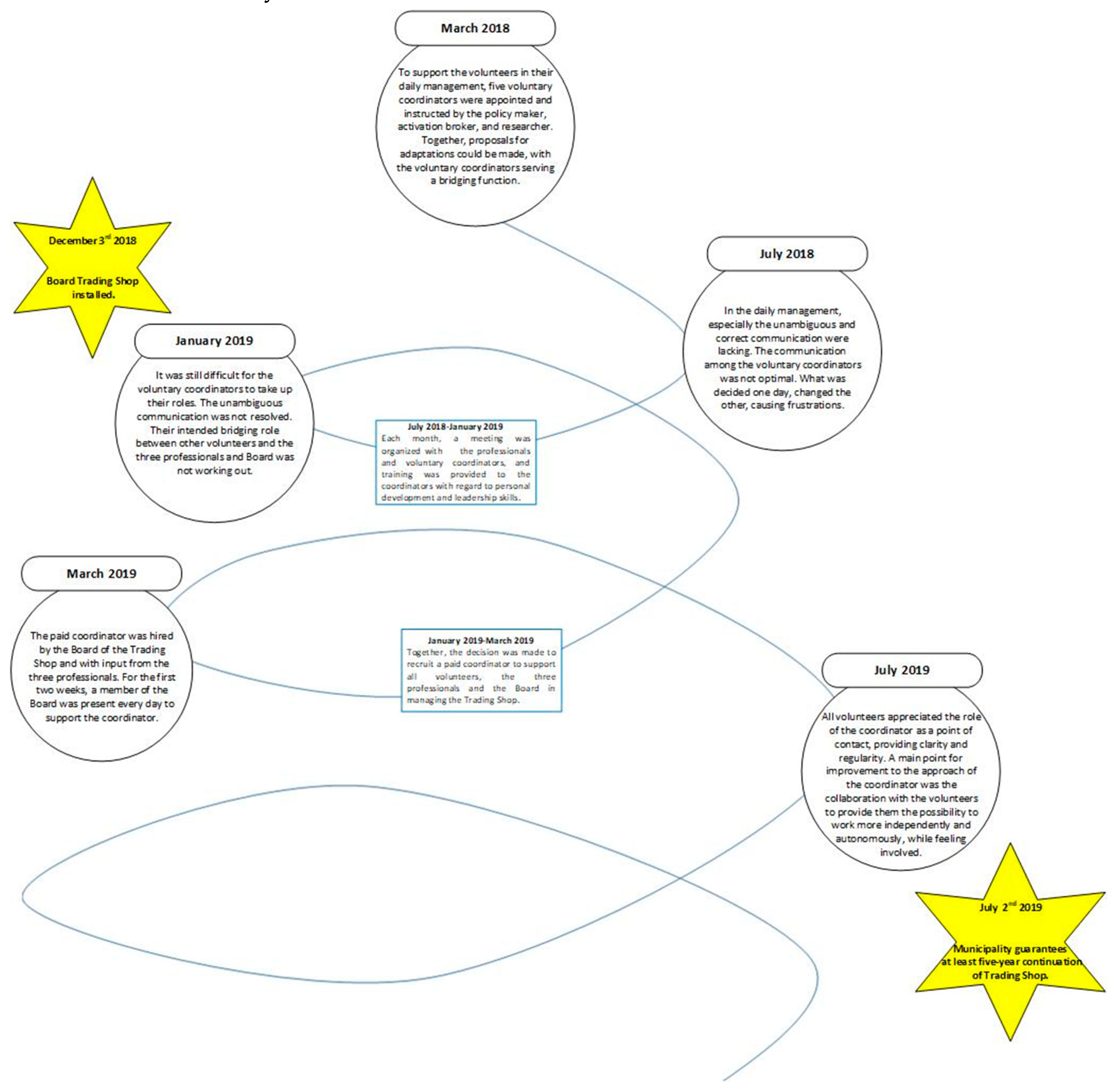The Power of Trading: Exploring the Value of a Trading Shop as a Health-Promoting Community Engagement Approach
Abstract
1. Introduction
2. Materials and Methods
2.1. Study Design
2.2. Study Setting
2.3. Goal of the Trading Shop and Its Community Engagement Approach
2.4. Data Collection, Instrument, and Measurements
2.5. Data Processing and Analysis
3. Results
3.1. The Preparation of the Trading Shop
3.2. The Starting Phase of Trading Shop Vaals
3.2.1. Engagement by Volunteers
3.2.2. Engagement by Visitors
3.2.3. Engaging the Community
3.3. Steps towards Continuation: A Five-Year Policy Plan for Trading Shop Vaals
4. Discussion
4.1. Strengths and Limitations
4.2. Future Research and Practice
5. Conclusions
Author Contributions
Funding
Conflicts of Interest
References
- Centers for Disease Control and Prevention (CDC). Principles of Community Engagement, 2nd ed.; Centers of Disease Control and Prevention: Atlanta, GA, USA, 2011. [Google Scholar]
- Arnstein, S.R. A ladder of citizen participation. J. Am. Plan. Assoc. 1969, 35, 216–224. [Google Scholar] [CrossRef]
- Carlson, E.D.; Engebretson, J.; Chamberlain, R.M. Photovoice as a social process of critical consciousness. Qual. Health Res. 2006, 16, 836–852. [Google Scholar] [CrossRef] [PubMed]
- International Association for Public Participation (IAP2). Spectrum of Public Participation: International Association for Public Participation. Available online: https://www.iap2.org/ (accessed on 10 November 2019).
- Ball, K. Traversing myths and mountains: Addressing socio-economic inequities in the promotion of nutrition and physical activity behaviours. Int. J. Behav. Phys. Act. 2015, 12, 1–7. [Google Scholar] [CrossRef]
- Mullainathan, S.; Shafir, E. Scarcity: Why Having Too Little means So Much; Henry Holt & Company LLC: Now York, NY, USA, 2013. [Google Scholar]
- Johnston, K.A.; Lane, A.B. Building relational capital: The contribution of episodic and relational community engagement. Public Relat. Rev. 2018, 44, 633–644. [Google Scholar] [CrossRef]
- Paton, M.Q. Developmental Evaluation: Applying Complexity Concepts to Enhance Innovation and Use; Guilford Publications: New York, NY, USA, 2012. [Google Scholar]
- Marmot, M. Closing the health gap. Scand. J. Public Health 2017, 45, 723–731. [Google Scholar] [CrossRef]
- Attree, P.; French, B.; Milton, B.; Povall, S.; Whitehead, M.; Popay, J. The experience of community engagement for individuals: A rapid review of evidence. Health Soc. Care 2011, 19, 250–260. [Google Scholar] [CrossRef]
- Commission on Social Determinants of Health. Closing the Gap in a Generation: Health Equity through Action on the Social Determinants of Health; Final report of the Commission on Social Determinants of Health; World Health Organization: Geneva, Switzerland, 2008. [Google Scholar]
- Barnett, L.; Kendall, E. Culturally appropriate methods for enhancing the participation of Aboriginal Australians in health-promoting programs. Health Promot. J. Aust. 2011, 22, 27–32. [Google Scholar] [CrossRef]
- Gillen, E.M.; Hassmiller Lich, K.; Yeatts, K.B.; Hernandez, M.L.; Smith, T.W.; Lewis, M.A. Social ecology of asthma: Engaging stakeholders in integrating health behavior theories and practice-based evidence through systems mapping. Health Educ. Behav. 2014, 41, 63–77. [Google Scholar] [CrossRef]
- Stollak, I.; Valdez, M.; Rivas, K.; Perry, H. Casas Maternas in the Rural Highlands of Guatemala: A Mixed-Methods Case Study of the Introduction and Utilization of Birthing Facilities by an Indigenous Population. Glob. Health Sci. Pract. 2016, 4, 114–131. [Google Scholar] [CrossRef] [PubMed]
- Subica, A.M.; Grills, C.T.; Douglas, J.A.; Villanueva, S. Communities of Color Creating Healthy Environments to Combat Childhood Obesity. Am. J. Public Health 2016, 106, 79–86. [Google Scholar] [CrossRef] [PubMed]
- Baybay, C.S.; Hindmarsh, R. Resilience in the Philippines through effective community engagement. Aust. J. Emerg. Manag. 2019, 34, 65–70. [Google Scholar]
- Goodman, R.M. A construct for building the capacity of community-based initiatives in racial and ethnic communities: A qualitative cross-case analysis. J. Public Health Manag. Pract. 2009, 15, E1–E8. [Google Scholar] [CrossRef] [PubMed]
- Zorbas, C.; McCartan, J.; De Mel, R.; Narendra, K.; Tassone, E.C.; Yin, E.; Palermo, C. Engaging a disadvantaged community with a fruit and vegetable box scheme. Health Promot. J. Aust. Off. J. Aust. Assoc. Health Promot. Prof. 2018, 29, 108–110. [Google Scholar] [CrossRef] [PubMed]
- Prevo, L.; Stessen, K.; Kremers, S.; Wassenberg, M.; Jansen, M. Shining light inside the tunnel: Using photovoice as a strategy to define the needs for health promotion among families of low socioeconomic status. Int. J. Qual. Stud. Health Well-Being 2018, 13, 154290. [Google Scholar] [CrossRef] [PubMed]
- Prevo, L.; Kremers, S.; Jansen, M. Small Successes make Big Wins: A retrospective case study towards community engagement of low-SES families. Int. J. Environ. Res. Public Health 2020, 17, 612. [Google Scholar] [CrossRef] [PubMed]
- Huber, M.A.S.; Van Vliet, M.; Giezenberg, M.; Knottnerus, J.A. Towards a Conceptual Framework Relating to Health as the Ability to Adapt and to Self-Manage; Rapport 2013-001 VG; Louis Bolk Instituut: Driebergen, The Netherlands, 2013. [Google Scholar]
- Baum, F.; Macdougall, C.; Smith, D. Participatory Action Research. J. Epidemiol. Community Health 2006, 60, 854–875. [Google Scholar] [CrossRef]
- Timmermans, S.; Tavory, I. Theory Construction in Qualitative Research: From Grounded Theory to Abductive Analysis. Sociol. Theory 2012, 30, 167–186. [Google Scholar] [CrossRef]
- Bharmal, N.; Derose, K.P.; Felician, M.; Weden, M.M. Understanding the Upstream Social Determinants of Health. Available online: https://www.rand.org/content/dam/rand/pubs/working_papers/WR1000/WR1096/RAND_WR1096.pdf (accessed on 12 February 2020).
- Van Lenthe, F.J.; Jansen, T.; Kamphuis, C.B. Understanding socio-economic inequalities in food choice behaviour: Can Maslow’s pyramid help? Br. J. Nutr. 2015, 113, 1139–1147. [Google Scholar] [CrossRef]
- Jansen, M.W.J.; Meisters, R.T.L. Rapportage Nulmeting en Monitoring: Sociale Agenda Provincie Limburg 2018; Province Limburg: Heerlen, The Netherlands, 2018. [Google Scholar]
- Gezondheidsatlas Zuid-Limburg. Thema’s Gezondheid Volwassenen en Ouderen Monitor. 2016. Available online: https://www.gezondheidsatlaszl.nl/volwdashboard.html (accessed on 9 September 2019).
- Prevo, L.; Jansen, M.; Kremers, S. A Jack of all Trades? Exploring the role of a broker in the societal activation process of long-term welfare recipients. Submitted. 2020. [Google Scholar]
- Diers, J. Neighbor Power, Building Community the Seattle Way; University of Washington Press: Seattle, WA, USA; London, UK, 2004. [Google Scholar]
- Letens, G.; Verweire, K.; Slagmulder, R.; Van Aken, E.M.; Cross, J. Integrating Top-Down and Bottom-up Change: Lessons Learned from a Longitudinal Case Study. In Proceedings of the Annual International Conference of the American Society for Engineering Management, Lubbock, TX, USA, 19–22 October 2011. [Google Scholar]
- Beer, M. How to Develop an Organization Capable of Sustained High Performance: Embrace the Drive for Results-Capability Development Paradox. Organ. Dyn. 2001, 29, 233–247. [Google Scholar] [CrossRef]
- Magee, J.C.; Galinsky, A.D. Social Hierarchy: The Self-Reinforcing Nature of Power and Status. Acad. Manag. Ann. 2008, 2, 351–398. [Google Scholar] [CrossRef]
- Mulvale, G.; Moll, S.; Miatello, A.; Robert, G.; Larkin, M.; Palmer, V.J.; Powell, A.; Gable, C.; Girling, M. Codesigning health and other public services with vulnerable and disadvantaged populations: Insights from an international collaboration. Health Expect. 2019, 22, 284–297. [Google Scholar] [CrossRef] [PubMed]
- O’Mallay, A.J.; Arbesman, S.; Steiger, D.M.; Fowler, J.H.; Christakis, N.A. Egocentric Social Network Structure, Health, and Pro-Social Behaviors in a National Panel Study of Americans. PLoS ONE 2012, 7, e36250. [Google Scholar] [CrossRef] [PubMed]
- Wallerstein, N.; Duran, B. Community-Based Participatory Research Contributions to Intervention Research: The Intersection of Science and Practice to Improve Health Equity. Am. J. Public Health 2010, 100 (Suppl. S1), S40–S46. [Google Scholar] [CrossRef] [PubMed]
- Koushede, V.; Nielsen, L.; Meilstrup, C.; Donoca, R.J. From rhetoric to action: Adapting the Act-Belong-Commit Mental Health Promotion Programme to a Danish context. Int. J. Ment. Health Promot. 2014, 17, 22–33. [Google Scholar] [CrossRef]



| Number of visitors |
| Number of visitors drinking a cup of coffee at the communal table |
| Number of visitors bringing products to the Trading Shop |
| Number of visitors “buying” products from the Trading Shop |
| Number of visitors in the target group (low-SES) families |
| Notes about remarks of visitors/members and volunteers |
| Question 1: Why do you visit the Trading Shop? |
| Question 2: Since when have you been visiting the Trading Shop? |
| Question 3: How often do you normally visit the Trading Shop? |
| Question 4: What do you like about the Trading Shop? |
| Question 5: Do you have any ideas to improve the Trading Shop? |
| Question 1: When did you start as a volunteer at the Trading Shop? |
| Question 2: How many days a week do you volunteer at the Trading Shop? |
| Question 3: What is your task within the Trading Shop? |
| Question 4: What do you like most about the Trading Shop? |
| Question 5: Did the Trading Shop support you personally? How? |
| Question 6: Do you have any ideas to improve the Trading Shop? |
| How have you experienced volunteer work at the Trading Shop? |
| What do you like, and what could be improved? |
| Looking at the future, what would you like to focus on in the next six months to enhance the Trading Shop? |
© 2020 by the authors. Licensee MDPI, Basel, Switzerland. This article is an open access article distributed under the terms and conditions of the Creative Commons Attribution (CC BY) license (http://creativecommons.org/licenses/by/4.0/).
Share and Cite
Prevo, L.; Kremers, S.; Jansen, M. The Power of Trading: Exploring the Value of a Trading Shop as a Health-Promoting Community Engagement Approach. Int. J. Environ. Res. Public Health 2020, 17, 4678. https://doi.org/10.3390/ijerph17134678
Prevo L, Kremers S, Jansen M. The Power of Trading: Exploring the Value of a Trading Shop as a Health-Promoting Community Engagement Approach. International Journal of Environmental Research and Public Health. 2020; 17(13):4678. https://doi.org/10.3390/ijerph17134678
Chicago/Turabian StylePrevo, Lotte, Stef Kremers, and Maria Jansen. 2020. "The Power of Trading: Exploring the Value of a Trading Shop as a Health-Promoting Community Engagement Approach" International Journal of Environmental Research and Public Health 17, no. 13: 4678. https://doi.org/10.3390/ijerph17134678
APA StylePrevo, L., Kremers, S., & Jansen, M. (2020). The Power of Trading: Exploring the Value of a Trading Shop as a Health-Promoting Community Engagement Approach. International Journal of Environmental Research and Public Health, 17(13), 4678. https://doi.org/10.3390/ijerph17134678





